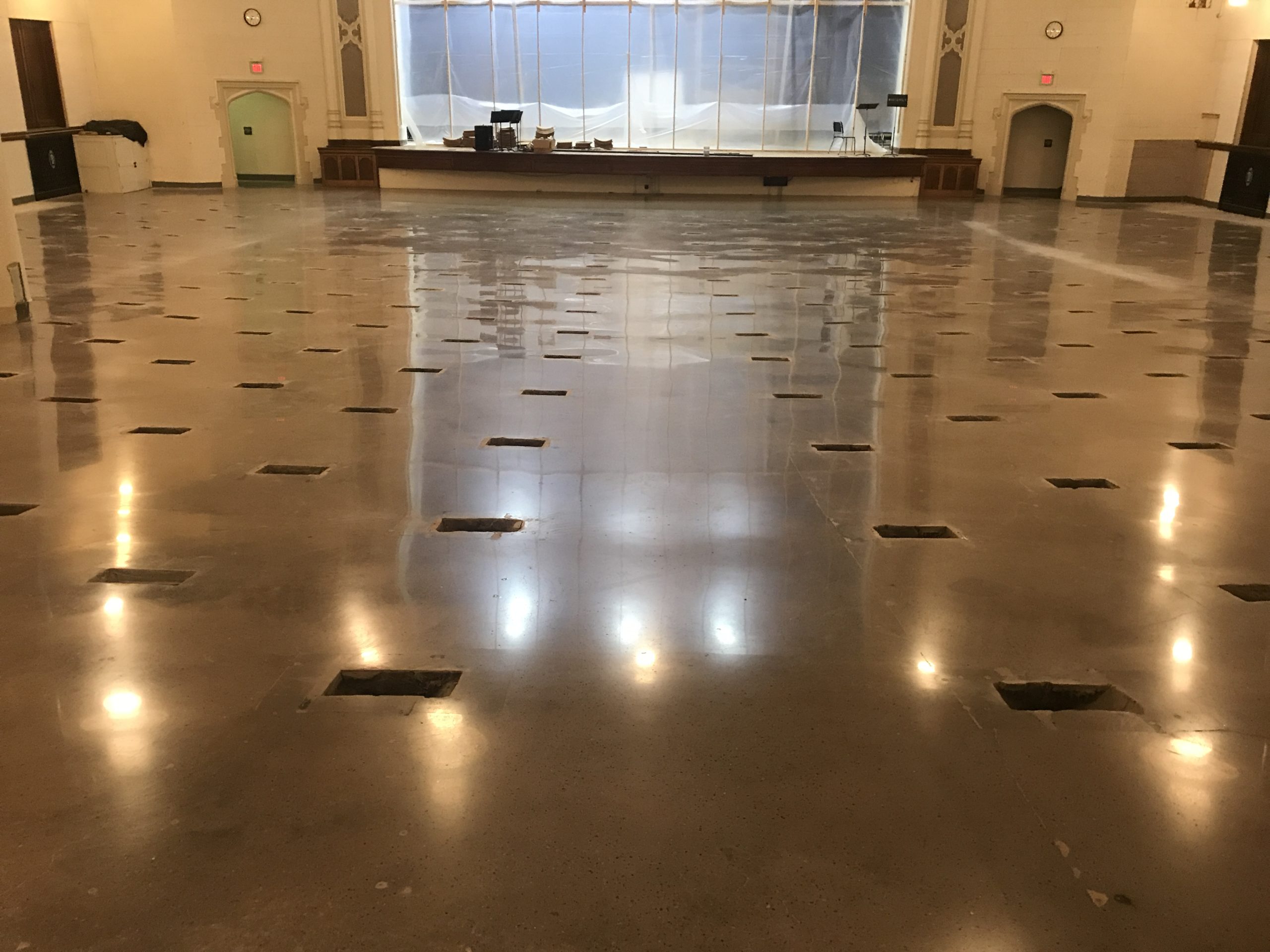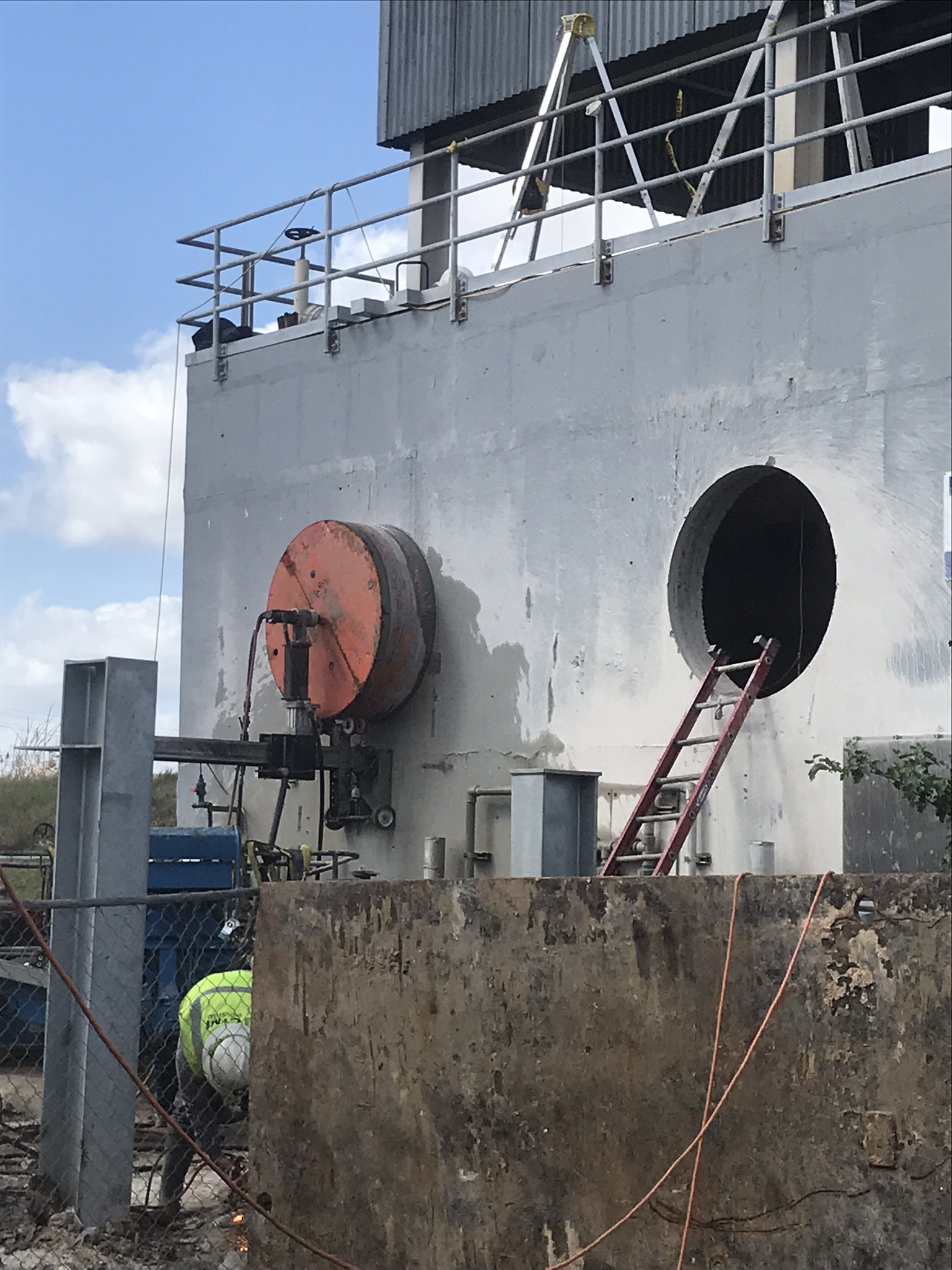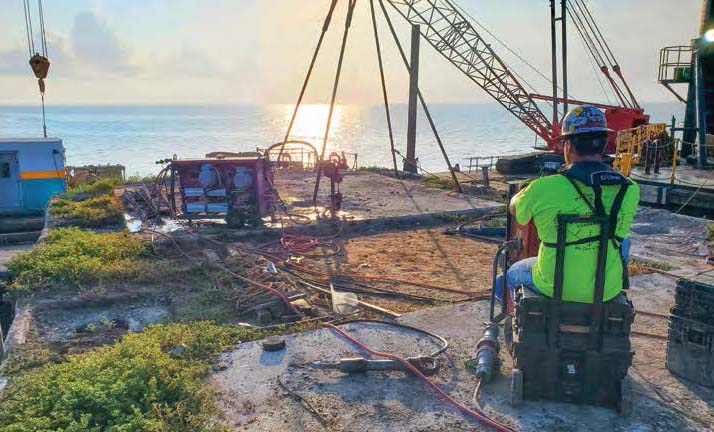
An Uphill Battle

Concrete Floor Polishing Specialist Restores School Auditorium
When faced with a 6,600-square-foot sloped floor that contained hundreds of damaged vents, a team of craftsmen from a concrete polishing contractor used brains and brawn to restore the floor of a 92-year-old school auditorium in Des Moines, Iowa.
Royale Concrete, a CSDA member from Fairfield, Iowa, had a literal uphill battle on its hands when the company accepted the job to revitalize the floor of the 2,036-seat auditorium, originally built in 1925, at Roosevelt High School. Honing the floor using surface preparation and polishing techniques was the school’s preference, but this was going to be a challenge for the contractor.

A 6,600-square-foot auditorium floor was restored to a honed finish.
The pitch of the floor, around 2 inches over 1 foot in some areas, meant that Royale’s grinders, which each weighed in excess of 900 pounds, struggled to keep course with the slope. Even the self-propelled remote control grinders were no match for the forces of gravity dragging them downward, so polishing machine operators had to use additional force to manually maneuver the grinders and keep them on course.
Adding to the challenge were over 300 closely-spaced degraded vent holes in the auditorium floor measuring 12 inches by 6 inches. It was difficult for the grinder operators to navigate around these openings without damaging the 32-inch-wide grinding heads and without falling into the holes. All this, plus a tight schedule of 10 days, meant that the operators from Royale Concrete had their work cut out for them. However, the polishing contractor’s team, lead by certified craftsman Justin Toben, decided to meet this challenge head on.
“We were incredibly proud of our craftsmen for tackling this challenging project,” commented Erin Ledger, Project and Operations Manager for Royale Concrete. “The client was thrilled with the results.”
To restore the Roosevelt High School Auditorium to its former glory, the client and contractor agreed on a honed concrete specification that utilized Husqvarna’s HiPERFLOOR® surface polishing system, dry grinding techniques, CTS’s Rapidset TruPC for cementitious repair and the Versaflex Quickmender system for patching. The system mechanically refined the already hard concrete surface through a process of grinding, honing and chemical treatments.

Concrete grinders were used to remove approximately 0.25 inch from the surface to reveal the aggregate below.
Toben and his team pushed two Husqvarna PG820 grinders around the incline to remove the worn surface and reveal the aggregate beneath approximately 0.25 inch of concrete. Both machines were attached to DC 5500 vacuum systems, also from Husqvarna, to control and collect dust and debris created during the grinding process. Gravity, of course, constantly pulled the machines down the slope of the floor, so the operators had to use their bodies to steer the machine in a straight path. During the grinding work, operators encountered lead imbedded in the floor and reinforcing steel buried 0.5 inch from the floor surface. It was very taxing physically to try to keep the grinders from veering in a downward motion, but the surface removal process for the entire floor was completed in 400 man hours.
The historic auditorium had hosted concerts, plays and student assemblies for over 90 years. As a result, its floor had experienced a lot of shuffling feet that created a well-worn surface and damage to items built into it. Over 300 degraded vent holes in the auditorium floor—functioning air conditioning vents that the school wanted to maintain for continuing use—needed a great deal of repair before being honed and finished with the rest of the floor.
Royale Concrete came up with a solution to repair the vent holes that was both effective and efficient. After the degradation around the vent holes had been prepped and cleaned, the team was ready to fill these areas with cementitious repair material. However, they still had to figure out a solution to repair the vent holes while retaining their function.
Toben pulled from his past experience with forming concrete countertops, and thought to use common foam insulation board as a form material for the vent holes. Using this easy-to-handle material allowed the team to quickly and easily customize the forms for each vent while also retaining the original rectangular shape and function of each vent. The grinders again had to be painstakingly maneuvered around the vent holes during the finishing process, but the use of the foam insulation material made for a swifter repair process. There was also a great deal of hand grinding and honing work required on the job too. The auditorium had an under-stage overhang where large grinders could not fit.
Once all the crack filling and vent repair work was completed, it was time to begin honing and refining the floor. For this part of the process, a series of metal resin diamond polishing pads and tooling was transitioned out to bring the floor to a 200-grit transition. At this stage, a Hyperhard densifier from Husqvarna was added before further tooling was applied to hone the floor to a 400-grit finish.

A series of metal resin diamond polishing pads and tooling was used to transition the floor to the specified 400-grit finish.
It was discovered on commencement of the work that a different type of aggregate had been used on the floor area in front of the auditorium stage. This meant that the contractor’s equipment would not produce the exact same finish in this area as the rest of the floor once honed. Therefore, the contractor employed a custom color-matching dye to bring the tone of this 575-square-foot area in line with the rest of the auditorium floor surface.
“Being solutions oriented is one of our company’s core values,” commented Toben. “Where others may hesitate about certain projects, we move forward determined to use each challenge as an opportunity to hone our craft and either learn or develop new ways of overcoming obstacles.”
Despite all the challenges that the project presented, the end result was a 6,600-square-foot floor that was both functional and aesthetically pleasing. The life cycle cost of this flooring option will be especially beneficial for the customer in terms of maintenance and lasting results. Concrete floors polished or honed can outlast other materials like carpet, wood, laminate and vinyl. The school was pleased with the finish and that the work was completed on time and within budget. Discussions have already taken place with the contractor regarding possible jobs in the future.
“Royale Concrete was honored to have been trusted by the Des Moines school district to complete such a challenging project. The company and its craftsmen look forward to the opportunity to serve the school system for many years to come,” says company owner Jessica Ledger-Kalen.
Roosevelt High School
Theodore Roosevelt High School, usually referred to simply as Roosevelt High School or TRHS, is a secondary school located on the west side of Des Moines, Iowa. It is one of five secondary schools under the district of the Des Moines Public Schools, and was named after the 26th President of the United States, Theodore Roosevelt.
The construction of the building in which TRHS is housed was initiated in 1922 by Proudfoot, Bird and Rawson and opened in 1924 with 1,282 students. The final cost to build was $1,331,600. The building’s design has won many awards and is considered one of 50 most significant buildings in Iowa by PBS. The building is on both the State and National Register of Historic Places. Today, the school has over 1,600 students each year.
Company Profile
Royale Concrete has been a CSDA member for two years and is based in Fairfield, Iowa. The company has been in business for 11 years. It has 10 employees and offers the services of surface preparation, polishing, coatings, urethane concrete and floor repair. Royale Concrete employs operators that are CSDA-ST-115 Certified and the company owner, Jessica Ledger-Kalen, is a CSDA Board member and chairperson of the association’s Polishing Committee.
Resources
General Contractor:
Des Moines School District
Polishing Contractor:
Royale Concrete
Fairfield, Iowa
Phone: 888-568-6001
Email: jlk@droyaleconcrete.com
Website: www.royaleconcrete.com
Methods Used: Concrete Polishing














